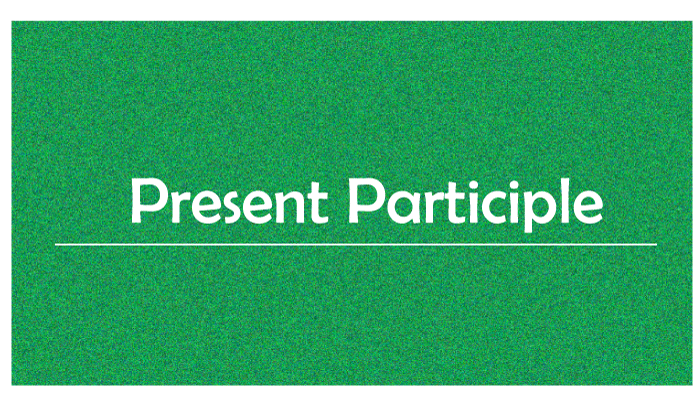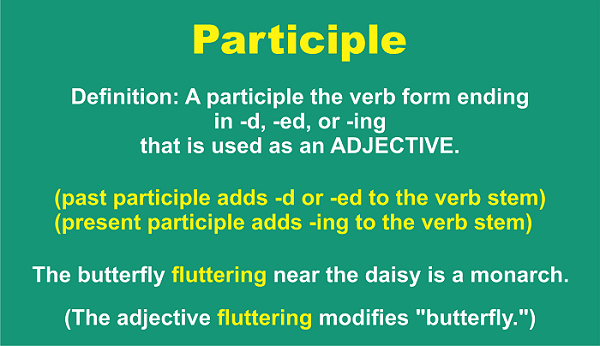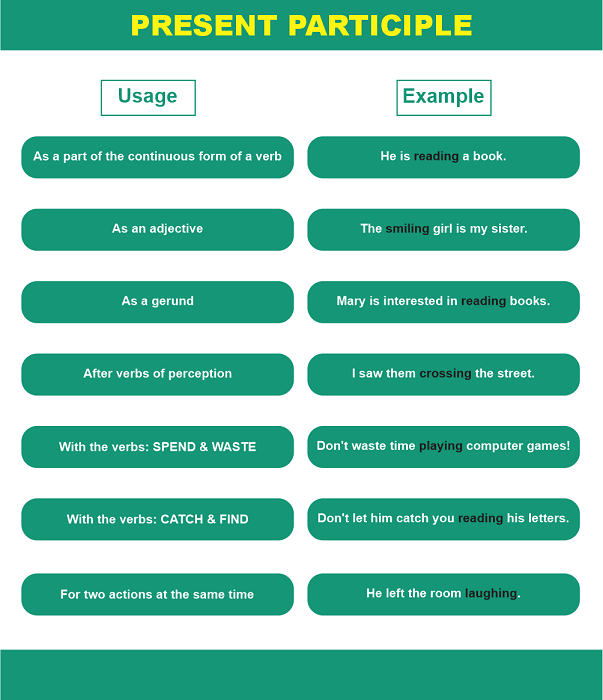Present ParticipleParticiples are useful terms that are frequently mixed up with verbs. This is understandable, given that participles frequently resemble verbs and are created from them. However, participles demand their own spotlight since they can do many tasks that verbs cannot. We shall now look at a particularly useful sort of participle known as the present participle. 
What Exactly Is a Present Participle?A participle is a type of term that is generated from a verb and can be utilized as an adjective or to build verb tenses. A present participle can be utilized as an adjective as well as to create continuous verb tenses. It is derived from a verb's root form. When you search for a verb in our great dictionary, you will locate the root form. To construct a present participle, we generally add -ing to the ending of the root form of a verb. The present participle of feed, for example, is feeding. However, there are a few more principles to remember while constructing present participles:

The last consonant of a one-syllable verb is repeated if it ends in consonant-vowel-consonant. The set turns into the setting, and chat turns into chatting, for example. If the last consonant of a lengthier verb is consonant-vowel-consonant, the last consonant is only repeated if the last syllable is emphasized. For instance, forget turns into forgetting, whereas orbit turns into orbiting. That's all there is to it! When transformed into present participles, irregular verbs behave similarly to regular verbs. Even the notoriously difficult verb be obeys the criteria and becomes being. Use Of Present ParticiplesIn phrases and clauses, we can employ present participles in a range of ways. They are frequently used as part of participle phrases, as adjectives, and to make continuous verb tenses. Present Participles in Participle PhrasesA participial phrase is a phrase that contains a participle in addition to other parts of speech like as nouns, modifiers, and prepositional phrases. Participle phrases function similarly to adjectives in that they are utilized to change nouns, pronouns, and noun phrases. In most cases, we would like the participle phrase to be as near to the word it changes as feasible. The following are some examples of present participles in participle phrases :
Participle phrases can also be used to start sentences. If we do, we use a comma to split the participle phrase from the main sentence.

The Adjective Form of Participles Present participles may also be employed as adjectives on their own. We place them right before nouns, similar to all other adjectives, or attach them to a subject using a connecting verb. As an example,
Use Participles as VerbsAlthough present participles are not employed as verbs on their own, they can be combined with other verbs to generate continuous verb tenses. Present Participles In Verb Tenses To construct the continuous tenses, present participles of verbs are combined with the verb be, and the statement will be. The phrase have/has been is utilized with present participles to produce the present perfect continuous tense, the phrase had been is used to create the past perfect continuous tense, and the phrase will have been is utilized to create the future perfect continuous tense. The following examples demonstrate how to employ present participles to construct six different verb tenses.
Why Are Present Participles Important?Present participles are helpful since they can achieve things that verbs cannot. By functioning as modifiers, present participles, like the other forms of participles, enable us to construct more complicated sentences. Consider a world without adjectives (the horror! ), and you'll see how vital present participles are. Furthermore, present participles are required to use continual verb tenses. Without present participles, English grammar would be devoid of many valuable tools with which to construct complex sentences. Here are two compelling reasons to consider present participles (particularly when used in participle sentences). Let's start with the advantage. (Benefit 1) A fronted participle phrase allows you to communicate 2 factors about your subject quickly. Participles can be used to construct a sentence structure that enables you to convey two or more aspects about your subject in a single sentence. As an example: Showing calmness in all business relationships, Matty listens consciously and engages adequately when in conflict. (In this instance, a present participle (bold) is embedded in a participle phrase (underlined). ) This participle-first structure is very handy when writing personal evaluations. It enables you to include an additional observation on your subject in a single statement. On the "non-finite verbs" page, you can learn more about the advantages of using participles. (Trap 1) Beware of misplaced and dangling modifiers ! When employing the sentence form in "Advantage 1," writers can cause uncertainty by forgetting to place the participle phrase adjacent to the word it modifies. For example : Showing calmness in all business relationships, clients regularly offer feedback on Matty - This is incorrect. (In this case, the participle phrase (shaded) may modify "clients" rather than "Matty." ) This is known as a misplaced modifier. ) A mismatched modifier causes your sentence to be confusing or incorrect. You can avert a misplaced modifier by putting it near to the thing it's changing. Let us now correct the example. Showing calmness in all business relationships, Mattey regularly receives feedback from clients. This is correct (The participle phrase is now located next to the word "Matty.") The ambiguity has vanished. ) Sometimes writers make a more serious blunder known as a hanging modifier. The phrase being modified isn't even present in the sentence when using a dangling modifier. As an example: Showing calmness in all business relationships, clients regularly offer feedback and come back to place more orders. Incorrect (In this case, the participle phrase (underlined) modifies nothing. "Matty" isn't referenced at all. This is known as a dangling modifier. ) What To Avoid When Using Present ParticiplesWhen utilizing present participles, there are some things to bear in mind. The first point to keep in mind is not specific to present participles: when utilizing any participle phrase, make it obvious what word/words are being altered. Typically, this is accomplished by placing the altered word/phrase as near to the participle phrase as possible. Evaluate your statements to ensure that you are not employing a participle phrase as a lost or dangling modifier. The sentences that follow offer an example of a well-utilized participle phrase in addition to two improper participle phrase usages. Correct: Grinning cheekily, Jennifer hid a rubber ball underneath her table. Misplaced modifier: Grinning cheekily, a rubber ball was hidden underneath Jenny's table. Dangling modifier: Grinning cheekily, her hands secured the rubber ball from sight. Gerund Vs. Present ParticipleSince they share identical forms, present participles and gerunds are easily confused. Gerunds, like present participles, are produced from verbs and finish in -ing. The present participle and gerund of the verb run, for instance, are both running. Gerunds and present participles, on the other hand, are utilized in quite different ways. To distinguish these two different, you must first understand how they are used: In continual verb tenses, present participles are employed as modifiers. Gerunds are nouns, which implies they can function as both subjects and objects. We can readily determine if a term is a gerund or a present participle using this information. Let's apply what we've learned to recognize the words in the following statements: Cooking is a nice activity. Cooking is the subject of the statement and functions as a noun in this statement. Thus, It's got to be a gerund. I purchased several cooking pots at the supermarket. Cooking is used as an adjective to alter the noun pots in this sentence. It must be in the present participle I hate tidying my room. The direct object of the statement in this statement is tidying my room. Tidying is a gerund that appears in the phrase tidying my room. We spoke with the worker washing the rooftops. Washing the rooftops modifies the noun worker in this sentence. Washing is a present participle that starts the sentence washing the rooftops.
Next TopicPresent Participle Examples
|
 For Videos Join Our Youtube Channel: Join Now
For Videos Join Our Youtube Channel: Join Now
Feedback
- Send your Feedback to [email protected]
Help Others, Please Share










